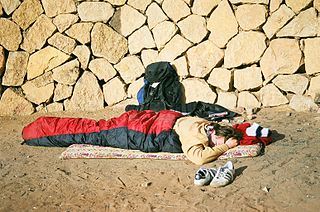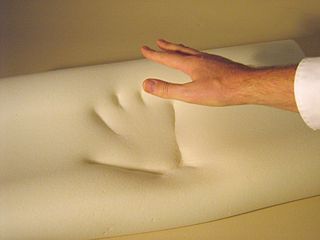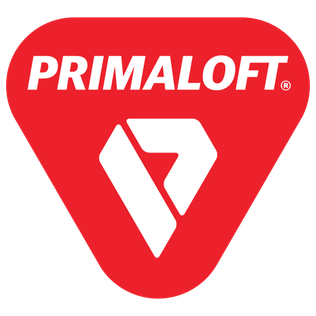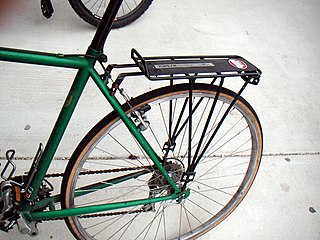
Horsepower (hp) is a unit of measurement of power, or the rate at which work is done, usually in reference to the output of engines or motors. There are many different standards and types of horsepower. Two common definitions used today are the imperial horsepower, which is about 745.7 watts, and the metric horsepower, which is approximately 735.5 watts.

A sleeping bag is an insulated covering for a person, essentially a lightweight quilt that can be closed with a zipper or similar means to form a tube, which functions as lightweight, portable bedding in situations where a person is sleeping outdoors. It is also commonly used indoors for people who do not have beds or at sleepovers. Its primary purpose is to provide warmth and thermal insulation through its synthetic or down insulation. It also typically has a water-resistant or water-repellent cover that protects, to some extent, against wind chill and light precipitation, but a tent is usually used in addition to a sleeping bag, as it performs those functions better. The bottom surface also provides some cushioning, but a sleeping pad or camp cot is usually used in addition to that purpose. The bottom surface of a sleeping bag may be moderately water repellent, but a plastic tarp or groundsheet is often used to protect against moist ground.

In camping, a ground pad, sleeping pad, thermal pad, sleeping mat, or roll mat is lightweight pad, common among hikers, backpackers and budget travelers, often used in conjunction with a sleeping bag. Its purpose is to provide padding and thermal insulation. All types currently available use air as their primary form of insulation.

A safe is a secure lockable enclosure used for securing valuable objects against theft or fire. A safe is usually a hollow cuboid or cylinder, with one face being removable or hinged to form a door. The body and door may be cast from metal or formed out of plastic through blow molding. Bank teller safes typically are secured to the counter, have a slit opening for dropping valuables into the safe without opening it, and a time-delay combination lock to foil thieves. One significant distinction between types of safes is whether the safe is secured to a wall or structure or if it can be moved around.
Earthbag construction is an inexpensive building method using mostly local soil to create structures which are both strong and can be quickly built.

Memory foam consists mainly of polyurethane with additional chemicals that increase its viscosity and density. It is often referred to as "viscoelastic" polyurethane foam, or low-resilience polyurethane foam (LRPu). The foam bubbles or ‘cells’ are open, effectively creating a matrix through which air can move. Higher-density memory foam softens in reaction to body heat, allowing it to mold to a warm body in a few minutes. Newer foams may recover their original shape more quickly.

A paper bag is a bag made of paper, usually kraft paper. Paper bags can be made either with virgin or recycled fibres to meet customers' demands. Paper bags are commonly used as shopping carrier bags and for packaging of some consumer goods. They carry a wide range of products from groceries, glass bottles, clothing, books, toiletries, electronics and various other goods and can also function as means of transport in day-to-day activities.

Water Resistant is a common mark stamped on the back of wrist watches to indicate how well a watch is sealed against the ingress of water. It is usually accompanied by an indication of the static test pressure that a sample of newly manufactured watches were exposed to in a leakage test. The test pressure can be indicated either directly in units of pressure such as bar, atmospheres, or as an equivalent water depth in metres.

Underfloor heating and cooling is a form of central heating and cooling that achieves indoor climate control for thermal comfort using hydronic or electrical heating elements embedded in a floor. Heating is achieved by conduction, radiation and convection. Use of underfloor heating dates back to the Neoglacial and Neolithic periods.

Ultralight backpacking is a style of lightweight backpacking that emphasizes carrying the lightest and least amount of gear. While no technical standards exist, some hikers consider "ultralight" to mean an initial base weight of less than 4.5 kg (9.9 lb). Base weight is the weight of a fully loaded backpack at the start of a trip, excluding worn weight and consumables such as food, water, and fuel. Base weight can be lowered by reducing the weight of individual items of gear, or by choosing not to carry that gear. Ultralight backpacking is most popular among thru-hikers.

Hammock camping is a form of camping in which a camper sleeps in a suspended hammock rather than a conventional tent on the ground. Due to the absence of poles and the reduced amount of material used, hammocks can be lighter than a tent, though this is not always the case. Most hammocks will also require less space in a pack than a similar occupancy tent. In foul weather, a tarp is suspended above the hammock to keep the rain off of the camper. Mosquito netting, sometimes integrated into the camping hammock itself, is also used as climatic conditions warrant. Camping hammocks are used by campers who are looking for lighter weight, protection from ground-dwelling insects, or other ground complications such as sloped ground, rocky terrain and flooded terrain.
Thermal comfort is the condition of mind that expresses subjective satisfaction with the thermal environment. The human body can be viewed as a heat engine where food is the input energy. The human body will release excess heat into the environment, so the body can continue to operate. The heat transfer is proportional to temperature difference. In cold environments, the body loses more heat to the environment and in hot environments the body does not release enough heat. Both the hot and cold scenarios lead to discomfort. Maintaining this standard of thermal comfort for occupants of buildings or other enclosures is one of the important goals of HVAC design engineers.
Fill power is a measure of the loft or "fluffiness" of a down product that is loosely related to the insulating value of the down. The higher the fill power, the more air a certain weight of the down can trap, and thus the more insulating ability the down will have. Fill power is commonly given as a specific volume, expressed in cubic inches per ounce. Common fill power values range from about 300 cubic inches per ounce (170 cm3/g) for feathers to around 900 in3/oz (520 cm3/g) for the highest quality goose down. The rare and relatively expensive down of certain wild waterfowl species such as the Muscovy duck or Common eider can have higher fill powers than goose down. Higher fill powers are associated with a larger percentage of down clusters and a larger average down cluster size.

PrimaLoft® is a brand of patented synthetic microfiber thermal insulation material that was developed for the United States Army in the 1980s. PrimaLoft is a registered trademark of PrimaLoft, Inc., the brand's parent company.
Insulated shipping containers are a type of packaging used to ship temperature sensitive products such as foods, pharmaceuticals, organs, blood, biologic materials, vaccines and chemicals. They are used as part of a cold chain to help maintain product freshness and efficacy. The term can also refer to insulated intermodal containers or insulated swap bodies.

A luggage carrier, also commonly called a (bicycle)rack, is a device attached to a bicycle to which cargo or panniers can be attached. This is popular with utility bicycles and touring bicycles.

A thermal bag is a type of thermally insulated shipping container in the form of a bag which can be carried, usually made of thermally insulating materials and sometimes a refrigerant gel. It is used to help maintain the temperature of its contents, keeping cold items cold, and hot items hot.

Security seals are tamper-evident mechanisms that seal valuable material in a room, cabinet, vehicle, or other storage facility. One common use is to seal cargo in transit shipping containers in a way that provides tamper evidence and some level of rudimentary security. Such seals can help to detect theft or contamination, either accidental or deliberate. Security seals are commonly used to secure truck trailers, vessel containers, chemical drums, airline duty-free trolleys, and utility meters. Typically they are considered an inexpensive way of providing tamper evidence of intrusion into sensitive spaces.

Package testing or packaging testing involves the measurement of a characteristic or property involved with packaging. This includes packaging materials, packaging components, primary packages, shipping containers, and unit loads, as well as the associated processes.

Shock-mitigating suspension seats are designed to reduce the severity of vibration and mechanical shock. These seats are used in vehicles that operate in high exposure environments, such as high-speed watercraft, military platforms, construction, forestry and agricultural vehicles, and industrial trucks. A vehicle's collisions with waves or rough terrain are a source of whole body vibration that may cause discomfort, acute injuries, and chronic pain among operators. The marine environment is particularly severe and people exposed to these conditions may experience unusually high injury rates.















